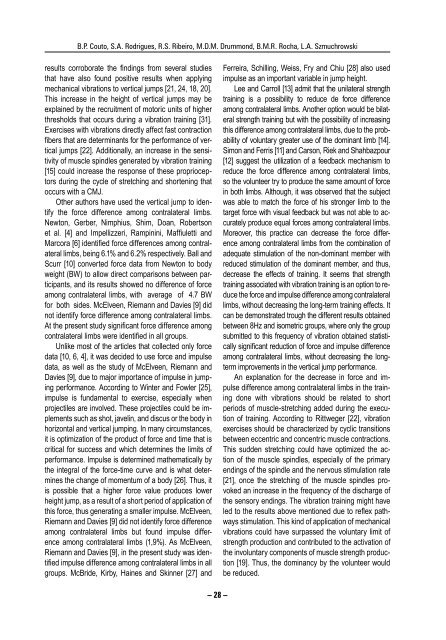Antropomotoryka nr 55.indb - Akademia Wychowania Fizycznego w ...
Antropomotoryka nr 55.indb - Akademia Wychowania Fizycznego w ...
Antropomotoryka nr 55.indb - Akademia Wychowania Fizycznego w ...
Create successful ePaper yourself
Turn your PDF publications into a flip-book with our unique Google optimized e-Paper software.
B.P. Couto, S.A. Rodrigues, R.S. Ribeiro, M.D.M. Drummond, B.M.R. Rocha, L.A. Szmuchrowski<br />
results corroborate the findings from several studies<br />
that have also found positive results when applying<br />
mechanical vibrations to vertical jumps [21, 24, 18, 20].<br />
This increase in the height of vertical jumps may be<br />
explained by the recruitment of motoric units of higher<br />
thresholds that occurs during a vibration training [31].<br />
Exercises with vibrations directly affect fast contraction<br />
fibers that are determinants for the performance of vertical<br />
jumps [22]. Additionally, an increase in the sensitivity<br />
of muscle spindles generated by vibration training<br />
[15] could increase the response of these proprioceptors<br />
during the cycle of stretching and shortening that<br />
occurs with a CMJ.<br />
Other authors have used the vertical jump to identify<br />
the force difference among contralateral limbs.<br />
Newton, Gerber, Nimphius, Shim, Doan, Robertson<br />
et al. [4] and Impellizzeri, Rampinini, Maffiuletti and<br />
Marcora [6] identified force differences among contralateral<br />
limbs, being 6.1% and 6.2% respectively. Ball and<br />
Scurr [10] converted force data from Newton to body<br />
weight (BW) to allow direct comparisons between participants,<br />
and its results showed no difference of force<br />
among contralateral limbs, with average of 4.7 BW<br />
for both sides. McElveen, Riemann and Davies [9] did<br />
not identify force difference among contralateral limbs.<br />
At the present study significant force difference among<br />
contralateral limbs were identified in all groups.<br />
Unlike most of the articles that collected only force<br />
data [10, 6, 4], it was decided to use force and impulse<br />
data, as well as the study of McElveen, Riemann and<br />
Davies [9], due to major importance of impulse in jumping<br />
performance. According to Winter and Fowler [25],<br />
impulse is fundamental to exercise, especially when<br />
projectiles are involved. These projectiles could be implements<br />
such as shot, javelin, and discus or the body in<br />
horizontal and vertical jumping. In many circumstances,<br />
it is optimization of the product of force and time that is<br />
critical for success and which determines the limits of<br />
performance. Impulse is determined mathematically by<br />
the integral of the force-time curve and is what determines<br />
the change of momentum of a body [26]. Thus, it<br />
is possible that a higher force value produces lower<br />
height jump, as a result of a short period of application of<br />
this force, thus generating a smaller impulse. McElveen,<br />
Riemann and Davies [9] did not identify force difference<br />
among contralateral limbs but found impulse difference<br />
among contralateral limbs (1,9%). As McElveen,<br />
Riemann and Davies [9], in the present study was identified<br />
impulse difference among contralateral limbs in all<br />
groups. McBride, Kirby, Haines and Skinner [27] and<br />
Ferreira, Schilling, Weiss, Fry and Chiu [28] also used<br />
impulse as an important variable in jump height.<br />
Lee and Carroll [13] admit that the unilateral strength<br />
training is a possibility to reduce de force difference<br />
among contralateral limbs. Another option would be bilateral<br />
strength training but with the possibility of increasing<br />
this difference among contralateral limbs, due to the probability<br />
of voluntary greater use of the dominant limb [14].<br />
Simon and Ferris [11] and Carson, Riek and Shahbazpour<br />
[12] suggest the utilization of a feedback mechanism to<br />
reduce the force difference among contralateral limbs,<br />
so the volunteer try to produce the same amount of force<br />
in both limbs. Although, it was observed that the subject<br />
was able to match the force of his stronger limb to the<br />
target force with visual feedback but was not able to accurately<br />
produce equal forces among contralateral limbs.<br />
Moreover, this practice can decrease the force difference<br />
among contralateral limbs from the combination of<br />
adequate stimulation of the non-dominant member with<br />
reduced stimulation of the dominant member, and thus,<br />
decrease the effects of training. It seems that strength<br />
training associated with vibration training is an option to reduce<br />
the force and impulse difference among contralateral<br />
limbs, without decreasing the long-term training effects. It<br />
can be demonstrated trough the different results obtained<br />
between 8Hz and isometric groups, where only the group<br />
submitted to this frequency of vibration obtained statistically<br />
significant reduction of force and impulse difference<br />
among contralateral limbs, without decreasing the longterm<br />
improvements in the vertical jump performance.<br />
An explanation for the decrease in force and impulse<br />
difference among contralateral limbs in the training<br />
done with vibrations should be related to short<br />
periods of muscle-stretching added during the execution<br />
of training. According to Rittweger [22], vibration<br />
exercises should be characterized by cyclic transitions<br />
between eccentric and concentric muscle contractions.<br />
This sudden stretching could have optimized the action<br />
of the muscle spindles, especially of the primary<br />
endings of the spindle and the nervous stimulation rate<br />
[21], once the stretching of the muscle spindles provoked<br />
an increase in the frequency of the discharge of<br />
the sensory endings. The vibration training might have<br />
led to the results above mentioned due to reflex pathways<br />
stimulation. This kind of application of mechanical<br />
vibrations could have surpassed the voluntary limit of<br />
strength production and contributed to the activation of<br />
the involuntary components of muscle strength production<br />
[19]. Thus, the dominancy by the volunteer would<br />
be reduced.<br />
– 28 –





![Antropomotoryka nr 57 [2012]. - Akademia Wychowania Fizycznego ...](https://img.yumpu.com/50213388/1/182x260/antropomotoryka-nr-57-2012-akademia-wychowania-fizycznego-.jpg?quality=85)











